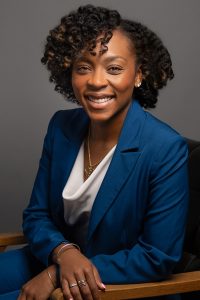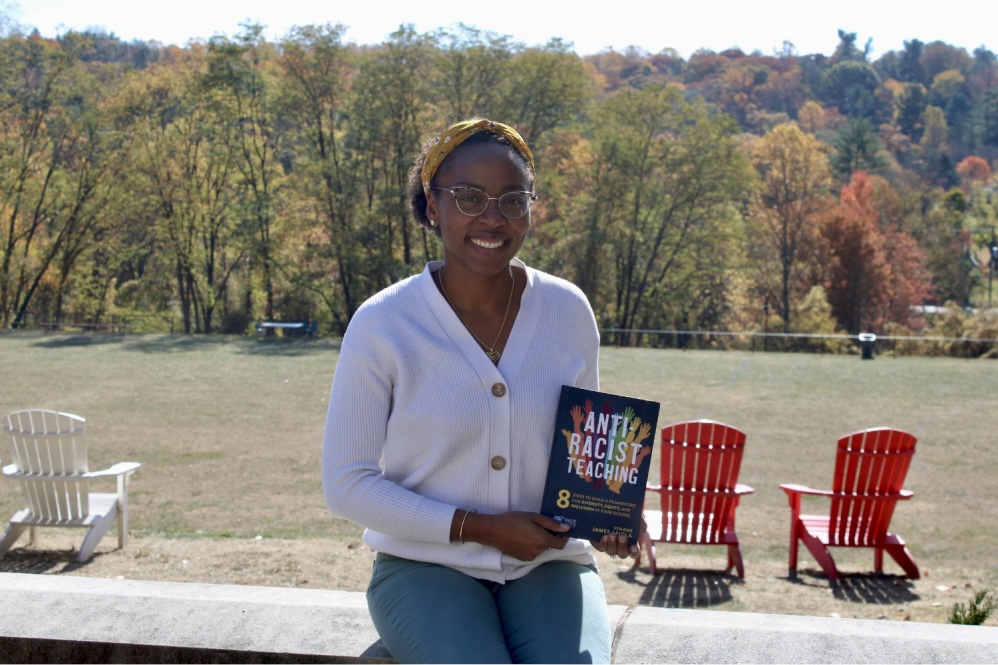In our recurring 10 Questions series, the Neag School catches up with students, alumni, faculty, and others throughout the year to offer a glimpse into their Neag School experience and their current career, research, or community activities.
Symone James Abiola ’16 (ED), ’17 MA, ’22 6th Year received her bachelor’s in elementary education, master’s in curriculum and instruction, and Sixth-Year Diploma in educational administration from the Neag School. For over six years, James Abiola worked as an elementary school teacher in the Meriden Public School District and now is the director of diversity, equity, inclusion, and belonging at Sacred Heart Academy Bryn Mawr in Pennsylvania.

In 2022, the American Consortium for Equity in Education presented her the Excellence in Equity: Champion of Equity-General Education Teacher Award, which was created to acknowledge and celebrate influential work at all levels of education and expand the discussion on educational equity.
Earlier this year, James Abiola published her first book, “Anti-Racist Teaching: 8 Steps to Build a Framework for Diversity, Equity, and Inclusion in Your School.” This book is part of the Hack Learning Series by Times 10 Publications, which aims to improve teaching and learning skills through practical advice from people who have experienced the issues they write about.
In this feature, we learn more about James Abiola’s new book and the importance of anti-racist practices in education.
Q: Where did the inspiration for this book come from? How long was this in the works for?
A: I started writing it in October 2022, but I wasn’t seeking the opportunity to be an author. In 2022, the director of equity and instruction for the district I worked in, Dr. Lysette Torres, submitted me for the Excellence in Equity award. I was then selected by Times 10 Publications to receive a book publishing contract after reviewing the nomination details.
Q: How did you get involved with the Hack Learning Series?
A: Times 10 Publications’ Hack Learning Series consists of different books that provide practical solutions for different topics in education. There is a template that you can use as an author to put the book together. This was very helpful as a new author, but there was also flexibility in making the book my own. Plus, it worked very well to have the opportunity to write something that aligns with the work I was already doing.
Q: How did you conduct research for this book?
A: I would say much of it is my own experiences, in and out of the classroom, as a teacher leader and administrator. I wouldn’t say there was a lot of specific research because I just lived it. However, I did seek out other educators to hear about their experiences. I was also thinking about what would be relevant and useful to the readers. Because of the work I was already doing, I had done a lot of reading and professional learning on the topic and included many books, other resources, and information from prominent voices in education, which I cited throughout the book.
Q: How do you feel now that you’ve completed this book?
A: Relieved! I didn’t know what to expect through this process or what the reception would be, and now I have even more respect and admiration for authors. I am so extremely grateful to have the opportunity to publish with Times 10 and the support they offered through the process. I don’t expect an explosion of sudden interest in the book, but I am working on getting the word out through events like panels and conferences. I’m still experiencing a lot of learning in this process; completion of the writing is just the beginning, and now I want to get it into the hands of readers. This is such an important topic; the more educators implement the steps in this book, the better for teachers, students, and families.
If we provide opportunities for learning and conversations before situations arise, then we can be more proactive in addressing bias, prejudice, and racism. — Symone James Abiola ’16 (ED), ’17 MA, ’22 6th Year
Q: What have you learned through the writing process that surprised you? And how does this compare with other projects you have been involved with?
A: One of the biggest things I’ve learned was how the whole publishing process worked, as I had never looked into it before. This experience was my first introduction; I lived it instead of just hearing or reading about it. When you believe in something, or you’re passionate about something, and you’re putting it on paper for other people to learn from, you can’t expect that somebody is just going to hear that you’re passionate and agree with you; you have to frame things. As an educator, this means framing things in a way where people can learn and you’re inviting people in. So, being able to write in a way that is understandable for anybody, wherever they’re at in learning about anti-racism or diversity, equity, and inclusion, can feel challenging. Still, as in real life, it’s important to bring people into these conversations.
Q: What is the relevance of this research, given the current academic climate?
A: It has always been important, but especially now when we’re seeing book bans and the silencing of educators on different topics. I think it’s very timely that educators have resources to learn about and implement anti-racist practices in their classrooms or within their school. This is not to say that this book is the definitive answer, but having another resource to guide you is helpful. In any school, people face different starting points and different challenges. In the book, I talk about creating an inclusive curriculum, ways to connect with families, professional learning, and many other topics. I think there’s something for everybody, no matter what you’re dealing with, and right now, it’s crucial for folks to have another relevant resource that may answer questions they have or offer solutions to challenges they’re facing when trying to build up their framework for diversity, equity, and inclusion.
Q: How did receiving your degrees from the Neag School prepare you for the creation of this book?
A: There were so many times in the book that I’ve mentioned UConn because it is so relevant. Generally, being a teacher gave me the foundation to write this book. Having my administrative certification allowed me to look at things from a classroom lens, and a schoolwide lens, which is so important to think about how things connect and affect one another. The UConn Administrator Preparation Program was comprehensive in helping us to think about that schoolwide lens, but also thinking about how data plays into it and what evidence you have to support what you’re doing. It’s helpful to have evidence to show the impact of what you’re doing. For a lot of folks, our lived experience is evidence, but not everybody understands or believes that, so being able to strategically collect and share information can be powerful.
There were so many times in the book that I’ve mentioned UConn because it is so relevant. Generally, being a teacher gave me the foundation to write this book. — Symone James Abiola ’16 (ED), ’17 MA, ’22 6th Year
Q: What brought your attention to the necessity of anti-racist education?
A: I would say my own experiences as a Black woman, and as a student. I look back on my experiences, such as in high school when a fight broke out in the cafeteria. A white teacher who had broken up the fight had said, ‘There’s nothing worse than getting your hand stuck in a Black girl’s hair.’ I sat there and thought, ‘Why on Earth would you think that’s appropriate to say?’ But of course, I was just a young kid, so I was just so shocked I didn’t say anything. If we provide opportunities for learning and conversations before situations arise, then we can be more proactive in addressing bias, prejudice, and racism.
Q: Why are inclusive/anti-racist teachings important in the classroom? What is the broader impact?
A: In the classroom, I really think about the student experience. Students can’t fully access the learning experience if they don’t feel it is safe. For example, if they’re being treated differently, or if their classmates are being hurtful, and there’s no pathway for learning or accountability, then the student’s learning experiences are going to be impacted. It’s essential to create a safe space for every child in school. Additionally, people often have the misconception that DEI work only impacts Black, Indigenous, and students of color. It’s also building empathy and understanding across all differences and identities and making sure everybody understands that we have a part to play when it comes to creating a sense of belonging, and that includes all school stakeholders. My hope is that when we create a framework for DEI, we are considering the future of our students and how they are going to leave classrooms with a strong sense of self, the courage to advocate for others, and the skills to think critically. The impact goes beyond the classroom.
Q: What do you hope educators take away from this book?
A: I really hope this offers educators a starting point or resources to continue DEI work and make it the foundation for everything else. I believe in being very intentional and taking time to learn about your school, your stakeholders, and your population and making changes based on their needs. So, I hope that educators can find tools to help them do that when they read this book.



